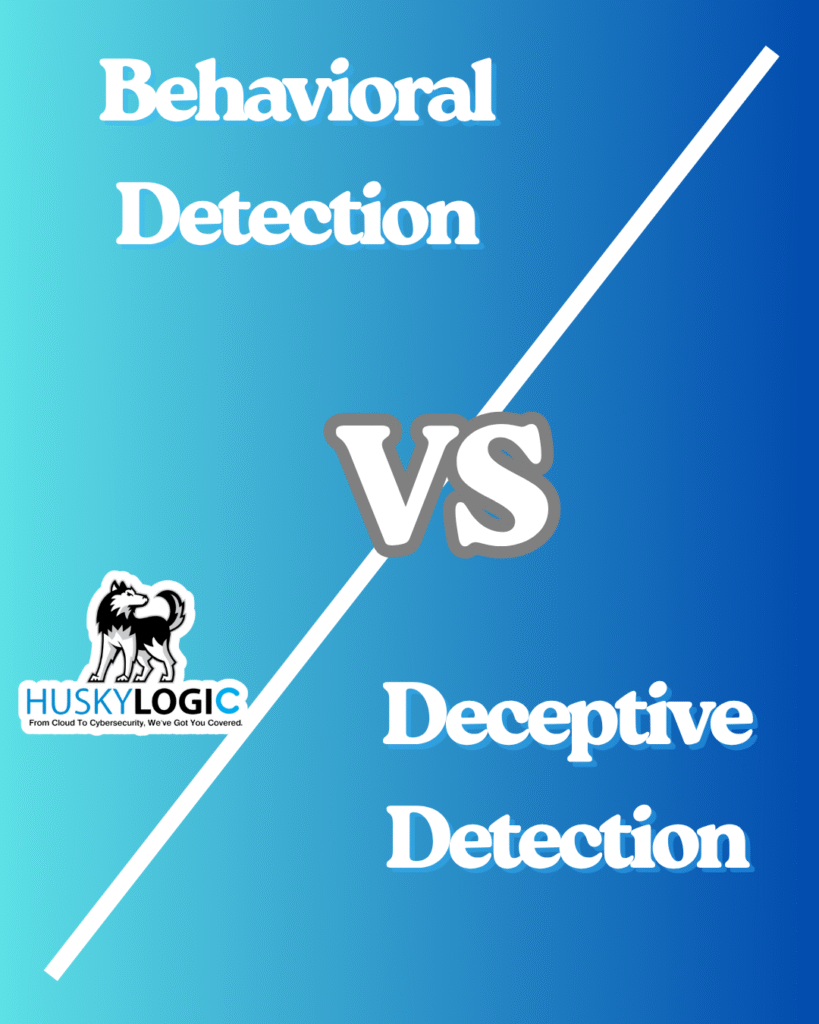Remember when the only thing you had to worry about with your computer was a simple virus? Back then, security was like having a lock on your front door. The lock worked great against people with a specific key, but what if a thief simply broke a window to gain entry? Traditional security systems, which looked for known “keys” (or signatures), would be completely lost.

Today’s hackers are the window-breakers. They don’t use the same “keys” twice. They find new and sneaky ways to infiltrate your systems, and traditional security tools often miss them. This is why cybersecurity has had to evolve. It’s no longer just about blocking known threats; it’s about being smarter than the bad guys. And that’s where two powerful ideas come in: behavioral detection and deceptive detection.
Behavioral Detection: The “Suspicious Behavior” Watchdog
Imagine you have a security guard who has been with your company for years. He knows everyone’s daily routine: he knows Jim from accounting always arrives at 9 a.m. and only opens spreadsheets, and he knows Sarah from marketing works from 10 a.m. to 6 p.m. and spends her day editing images.
This guard isn’t looking for a “bad person.” He’s looking for unusual behavior. If he sees Jim from accounting suddenly logging in at 3 a.m. and copying a thousand sensitive files, he knows something is wrong. That’s what behavioral detection does for your computer.
The system learns what’s “normal” for your network or device over time. It notices that a certain program on your computer has never connected to the internet before, or that a specific server has never tried to access files in another department. When a program or a user does something that breaks this “normal” routine, the system flags it as suspicious.
The biggest benefit of this approach is that it can catch a brand-new threat that no one has ever seen before. It doesn’t need to know what a virus looks like; it just needs to know what a virus acts like.
Deceptive Detection: The “Digital Trap”
Now, let’s go back to our house security analogy. Behavioral detection is a great way to notice a broken window, but what if you could trick the thief?
Deceptive detection is like setting up a digital trap. Cybersecurity experts will create “fake” versions of important network components—such as a fake customer list, a phony bank account, or a decoy server. These aren’t real and contain no valuable information. To a hacker, however, they look completely genuine and very tempting.
They are essentially digital bait. The moment a hacker tries to access or interact with one of these fake items, a silent alarm goes off. Security teams know instantly that there’s a real intruder on the network because no legitimate user would ever interact with these fake assets.
This is a powerful tool because it gives a security team a high-confidence alert and lets them watch what the hacker is doing in a safe, fake environment. They can learn about the hacker’s tools and plans without putting any real data at risk.
The “Suspicious Behavior” Watchdog: What It Does Well (and Not So Well)
Every smart security system has its strengths and weaknesses, and our “Suspicious Behavior” Watchdog—behavioral detection—is no different.
The Good Stuff (Pros):
- Catches the Unseen: This is its superpower! Because it’s looking for unusual actions rather than a list of known bad guys, behavioral detection can spot brand-new attacks that no one has ever seen before. These are often called “zero-day” attacks, and they’re what keep security experts up at night. Behavioral detection gives you a fighting chance against them.
- Finds the Inside Job: Sometimes, the biggest threat comes from within. An employee who suddenly starts acting suspiciously or an account that gets taken over by a hacker can be hard to spot with traditional methods. But if their actions deviate from their “normal” routine, the behavioral watchdog will notice. This makes it excellent at catching insider threats.
- Learns and Adapts: It’s not a static system. The more it watches, the smarter it gets. It constantly learns what’s normal in your environment, making it more effective over time.
The Not-So-Good Stuff (Cons):
- The “False Alarm” Problem: Imagine our security guard flagging Jim from accounting because he came in early one time to finish a project. Behavioral detection can sometimes raise false positives, meaning it flags legitimate, but unusual, activity. This can lead to extra work for security teams trying to figure out if it’s a real threat or just something quirky.
- Needs Time to Learn: When you first set up behavioral detection, it’s like a new security guard on their first day—they don’t know anyone’s routine yet. It needs a period to observe and build its baseline of “normal” behavior. During this initial learning phase, it might not be as effective and could generate more false alarms.
- Clever Hackers Can Blend In: Some very sophisticated hackers might try to “live off the land.” This means they use normal, legitimate tools that are already on your computer (like certain built-in programs) but use them for malicious purposes. Since these are “normal” tools, behavioral detection might struggle to see the difference between their legitimate use and their abusive use. This doesn’t matter if the hacker is using this otherwise normal software for unusual tasks. They might use a program usually meant for writing documents to secretly run a harmful task, which the system might not immediately see as ‘bad’ because the program itself is ‘normal
The “Digital Trap”: What It Does Well (and Not So Well)
Our “Digital Trap”—deceptive detection—is a clever way to catch hackers, but like any smart tool, it has its particular strengths and a few areas where it’s not a silver bullet.
The Good Stuff (Pros):
- No More Guessing Games: This is where deceptive detection truly shines! When a hacker interacts with a fake decoy, you know with almost 100% certainty that it’s a genuine threat. It means security teams get high-confidence alerts, leading to very few “false alarms.” There’s no mistaking a burglar grabbing a fake diamond from the homeowner, just moving furniture around.
- Catches Them Early: Unlike systems that only react after damage is done, deceptive detection can catch hackers very early in their process. Often, they’re just exploring your network, looking for valuable information. When they stumble upon a decoy, you know they’re there before they’ve reached your real data. This allows for early detection and a quicker response.
- Pulls Back the Curtain: When a hacker gets caught in the “trap,” security teams can watch what they do inside the fake environment. This provides invaluable threat intelligence. You can see what tools they’re using, what they’re trying to find, and how they operate, without any risk to your real systems. It’s like having a hidden camera watching the thief.
- Wastes Their Time: By making hackers engage with fake assets, you can distract and frustrate them. They’ll spend time and resources trying to break into something worthless, buying your security team crucial time to prepare and respond.
The Not-So-Good Stuff (Cons):
- It Needs Bait: Deceptive detection only works if a hacker interacts with one of your decoys. A very clever and targeted hacker who already knows exactly where your valuable information is might simply bypass the fake traps. It’s not a complete “force field” that stops every single attack.
- Can Be Tricky to Set Up: Creating convincing fake environments that hackers believe are real can be complex. You need to make sure the decoys look and act authentic, which requires careful planning and maintenance. It’s not as simple as flipping a switch.
- Not a Standalone Solution: While powerful, deceptive detection is best used as part of a larger security strategy. It’s fantastic at confirming a threat and gathering intelligence, but it doesn’t prevent all types of attacks on its own. Think of it as a specialized tool in a bigger toolbox.
The Uncomfortable Truth: No Security is 100% Perfect
It’s tempting to think that with all these clever new security tools, we can finally build an unbreakable digital fortress. The uncomfortable truth, however, is that no security system, no matter how advanced, can guarantee 100% protection all of the time.
Why not? Think about it this way:
- The Attackers Are Smart (and Relentless): There are always clever people (hackers) constantly trying to find new weaknesses. It’s an ongoing race between those who protect and those who attack. As soon as one defense is created, someone is trying to figure out how to get around it.
- Human Factor: Even the best technology can’t always account for human error. A simple mistake, like someone accidentally clicking a bad link, can open a door even the smartest systems might struggle to close immediately.
- Complexity: Today’s computer systems are incredibly complex, with many different parts talking to each other. More complexity means more tiny cracks where a determined attacker might try to squeeze through.
The goal of cybersecurity isn’t to achieve an impossible 100% security. Instead, it’s about making it as difficult as possible for hackers to succeed, quickly catching them when they do break in, and minimizing any potential damage.
If You Could Only Choose One…
If you were forced to pick just one of these advanced defense strategies – behavioral detection or deceptive detection – which would be better?
This is a tough question because they offer different benefits.
- Behavioral detection is excellent for broadly catching any unusual activity, even completely new attacks. It’s like having a very attentive security guard who notices even the slightest deviation from normal routine. Its main challenge is sometimes crying wolf (false positives).
- Deceptive detection is fantastic for providing rock-solid proof of an intrusion with almost no false alarms. It’s like having a perfectly hidden trap that only a burglar would trigger. Its main challenge is that a hacker has to stumble into the trap.
If you could only choose one, behavioral detection would likely be the more essential foundation. Why? Because it offers broader coverage. It’s constantly watching everything for anomalies, giving you a chance to detect unknown threats across your entire system. While deceptive detection provides incredibly valuable, high-fidelity alerts, it relies on an attacker interacting with a specific bait. Behavioral detection, by constantly learning and monitoring, offers a more general “safety net” against the ever-changing tactics of cybercriminals, even if it comes with the occasional false alarm.
However, the reality is that these tools are truly powerful when they work together, creating layers of defense that make it far harder for anyone to compromise your digital safety.
The Power of Both Together
So, which method is better? The answer is that they work best as a team.
Behavioral detection is great for noticing something is a little off, but it can’t always be 100% sure. Deceptive detection provides the rock-solid proof.
Here’s a real-world example of how they work together:
- A hacker gets into your company’s network through a sneaky email.
- Behavioral detection notices that the hacker’s actions are strange—they’re moving around the network in a way no one ever has before.
- The hacker, thinking they’re being clever, finds what looks like a valuable server and tries to access it. But it’s a deceptive detection decoy.
- The moment the hacker touches that decoy, a definitive alarm sounds. The security team knows for a fact it’s a real threat and can begin to neutralize it immediately.
The combination of these two approaches is making our digital world much safer. It shows that modern security isn’t just about building higher walls; it’s about being smarter than the hackers, watching for suspicious actions, and setting clever traps to outwit them. It’s a new, more intelligent way to guard your digital life. If you’re curious to investigate further or need help securing your systems, don’t hesitate to reach out to Husky Logic. You can call us directly at 716-775-7002 or visit our contact page to get started.


